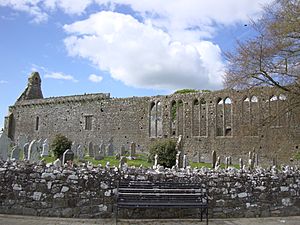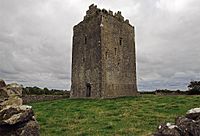Lorrha facts for kids
Quick facts for kids
Lorrha
Lothra
|
|
|---|---|
|
Village
|
|
| Country | Ireland |
| Province | Munster |
| County | County Tipperary |
| Time zone | UTC+0 (WET) |
| • Summer (DST) | UTC-1 (IST (WEST)) |
Lorrha (from Irish: Lothra) is a small village in the northern part of County Tipperary, Ireland. It is sometimes called 'Larah' or 'Loragh'.
Lorrha is located on a small road. This road connects the R489 road (from Birr to Portumna) and the N65 road (from Nenagh to Portumna). It is about five kilometers east of where the River Shannon flows into Lough Derg.
Lorrha is also the name of a townland (a small area of land) and a civil parish. These are in the historic barony of Ormond Lower. The civil parish shares borders with Portumna in County Galway and Birr in County Offaly.
Contents
History of Lorrha
In the year 843, a group of Norsemen (Vikings) led by Turgesius attacked Lorrha and a nearby place called Terryglass. Records suggest that the abbey in Lorrha was damaged by fire and unroofed a long time ago.
The area near Lorrha has always been important for crossing the River Shannon. There have been many bridges and ferry crossings here over the years. The current Portumna bridge was built in 1911.
Ancient Religious Buildings
Lorrha has a long and interesting religious history. You can see this in the old ruins and active churches in the village. The Roman Catholic Church of St. Ruadhan was built around 1912.
Dominican Friary Ruins
At the south end of the village, you can find the remains of a Dominican Friary. This friary was founded in the 13th century by Walter de Burgh, who was an Earl of Ulster.
The ruins show a long building. It has tall side walls and windows with stone dividers. The east end of the building is mostly gone, but the west end still has a nice Gothic window. This window was also used as a bell tower. Inside, there are many stone tablets with Latin writing. One of these tablets, made of polished marble, shows the family crest of the Mac Egan family.
St. Ruadhan's Church Site
To the east of the village is the Church of Ireland. This church stands on the site of St. Ruadhan's church, which was built around 1000 AD. Even earlier, St. Ruadhan's Abbey was founded here in the 6th century. In the churchyard, you can still see parts of two high crosses from the 8th century.
Lorrha Abbey
The Augustinian Abbey was founded in the 12th century by the Order of Canons Regular. It is located nearby. A carved head above the door is thought to be a picture of Walter De Burgh's wife. The water for the monks came from St. Ruadhan's well, which is south of the road near the Church of Ireland cemetery.
Lorrha Castle Ruins
On the north side, very close to the abbey, are the ruins of an old building. It is covered in so much ivy that it's hard to see the walls. People think it might be the remains of a castle, even though some believe it was part of the abbey.
The Lorrha Missal is an important old book. It is a translation of a Latin and Gaelic Missal (a book used for church services). It was copied in Lorrha in the 9th century. Today, it is usually called the Stowe Missal.
Important Buildings in Lorrha
- Lackeen Castle: This was a strong castle belonging to the Kennedy family. It was built in the 12th century and rebuilt in the 16th century. Sometimes, it is open for visitors. The Lorrha Missal was found hidden inside a stone wall here in the 18th century.
- Redwood Castle: This is a Norman castle that was built around 1200.
- Abbeville: This is a small country house built around 1840, connected to an older building.
- The Church of Ireland: This church has a beautiful stained glass window. It was made by Michael Healy in 1918 and shows The Holy Women at the Tomb.
Religion in Lorrha
For people who follow the Christian faith, Lorrha has both a Roman Catholic church and an Anglican church that are still active. Lorrha is a church area (an ecclesiastical parish) within the Roman Catholic Diocese of Killaloe.
Sports and Fun
Lorrha–Dorrha is the local GAA sports club. GAA stands for Gaelic Athletic Association, and they play traditional Irish sports like hurling and Gaelic football. Many famous players have connections to Lorrha–Dorrha.
Lorrha is also on the Ormond Way. This is part of the Beara-Breifne Way, which is a very long path for walking and cycling. It stretches from the Beara Peninsula in County Cork all the way to Blacklion in County Cavan.
Local Government Representation
The areas of Lorrha East and Lorrha West are part of the Dáil (Irish Parliament) constituency of Offaly. This area includes 24 electoral divisions that used to be in the Tipperary North Dáil constituency.
Famous People from Lorrha
- Ruadán mac Fergusa Birn (6th century): He was the founder and first abbot of the monastery in Lorrha.
- Cú Connacht mac Dundach (died 1006): He was a King of Síol Anmchadha and died near Lorrha.
- Martin O'Meara VC (1882–1935): Born in Sharragh, Lorrha, he received the Victoria Cross for bravery.
- Martin Charles Reddington (1919–2015): An Irish sportsperson who played hurling for Lorrha-Dorrha GAA.
- Liam King (born 1940): Born in Lorrha, he is a retired Irish sportsperson.
- John McIntyre (born 1961): Born in Lorrha, he is an Irish hurling manager and former player.
- James Kenneth Hogan (born 1963): Born in Lorrha, he is a current Irish hurling manager and former player.
- Patrick (Bonner) Maher (born 1989): A current Irish sportsperson who plays on the Tipperary senior hurling team.





